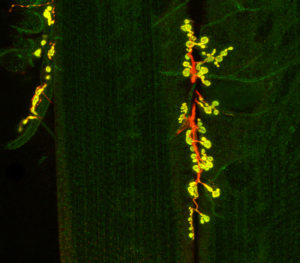Dr. Faith Liebl Receives $422,064 Award
“The brain is fascinating in how this collection of cells can give rise to thought.”–Dr. Faith Liebl

A neuromuscular junction synapse in Drosophila. Photo Credit: Dr. Faith Liebl
Dr. Faith Liebl has a big question in her lab at Southern Illinois University Edwardville—“How do we learn and remember information?” More specifically, she wants to understand how genes in the brain can contribute to neurological disorders such as autism. Along with her big question she was awarded a three-year grant for $422,064 from the National Institutes of Health, the largest funder of biomedical research in the world.
How does one even go about studying gene expression in the brain though? Liebl’s model organism is Drosophila, more commonly known as the fruit fly. In the last decade alone, researchers have been able to map the fruit fly’s brain and it just so happens that their synapses are similar enough to our own, making them a great model organism for study. When it comes to gene expression, your genes produce all of the proteins in your body that enable you to function. This includes proteins in your brain which are responsible for how your brain develops and functions and in turn, how you think, feel, and behave. Liebl’s research will focus on a very specific protein in the brain known as Kismet. Mutations in Kismet can lead to neurodevelopmental disorders like CHARGE Syndrome and autism spectrum disorders.
Having a large research project surrounding Kismet means that there are numerous sub-projects that Liebl will be exploring over the next three years. As such, a day in her lab involves managing many pieces of the project. “Every day, we’re all working together to answer ten or more questions at a time. Students are working on maybe one piece of a sub-project. This grant has enabled me to take on more students for this research and to also work on some experiments of my own” (Liebl).
Findings from research such Dr. Liebl’s can lead to greater understanding of overall gene expression in the brain and lend insight into the development of new treatments for neurological disorders. “My hope is, in understanding synaptic physiology, we can identify potential targets for future treatments of some of these neurological disorders.”
Filed Under: Biological Sciences • Faculty News












